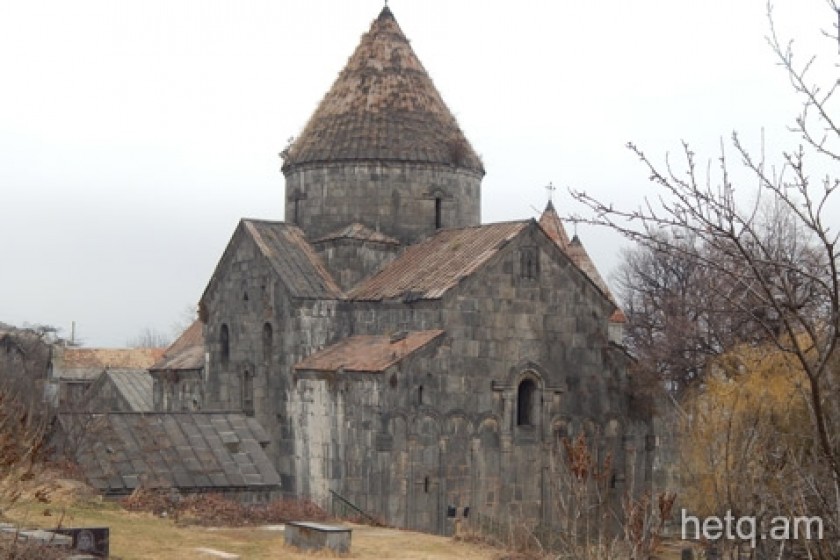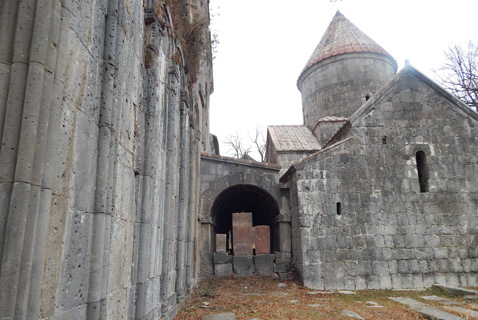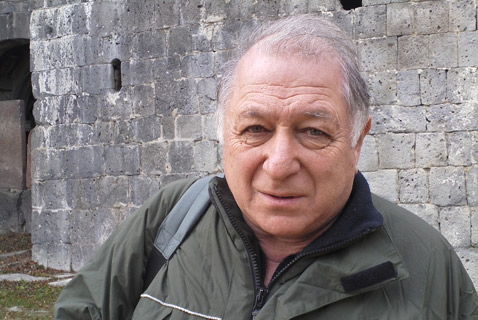
Sanahin in Trouble: Millions Spent but Church Roofs Still Leak
The 40.5 million AMD already allocated from Armenia’s state budget to restore and reinforce the Sanahin monastery complex has been misspent. And this squandering of tax payer money has occurred right under the nose of the Ministry of Culture.
It’s all part of an ambitious four year project (2012-2016) to renovate Sanahin, a jewel of Armenian early medieval architecture, in the country’s northern region.
Work to restore and reinforce the churches of St. Astvatzatzin (10th c.) and St. Amenaprkich (966 A.D), along with the Grigor Magistros Seminary, began in the fall of 2012 on the instructions of Prime Minister Tigran Sargsyan. 18 million AMD was allocated that year.
Some of the money was to go towards removing plant growth from the roof and walls of St. Astvatzatzin and to reinforce its stone walls.
Hovik Veranyan, the complex’s 70 year-old watchman, was able to remove the top layer of plant growth but wasn’t able to get down under the stones to the roots. So, whatever he did, hasn’t the resolved the problem of cracking walls and leaky roofs.
“I cleaned the church roof. But to get down to the roots, the cement has to be broken up and stones removed from the walls. They told me just to cut the branches,” Mr. Veranyan said.
 Workers removed the church’s roofing tiles in 2012 and reinstalled them on a section of the roof. Workers covered the remaining section with plastic sheeting and left the job. This is the extent of the restoration work on St. Astvatzatzin for which the 18 million AMD was allocated.
Workers removed the church’s roofing tiles in 2012 and reinstalled them on a section of the roof. Workers covered the remaining section with plastic sheeting and left the job. This is the extent of the restoration work on St. Astvatzatzin for which the 18 million AMD was allocated.
In 2013, 22.5 million AMD was allocated from the state budget to restore and reinforce the church’s outer vestibule and the Grigor Magistros Seminary.
Hetq has revealed that no such work was carried out in 2013 on the vestibule. As for the seminary, on which partial work was done, its roof and walls continue to leak. Instead, workers went back to the section of the church’s roof left unfinished in 2012 and installed tiles.
They also removed some loose stones from the church’s façade. After cleaning the underlying surface, the stones were replaced. But they did such a lousy job that the already decrepit stones were damaged even more.
Alaverdi parish priest Father Mikayel Shaghoyan told Hetq that the first and second stages of the restoration work at the Sanahin complex are complete. The third stage will begin this spring. Father Shaghoyan says the team of specialists working at the site is quite pleased with the work done so far.
Ahana Ltd. was the company that won the tender for the project announced by the Ministry of Culture in 2011. The restoration plan presented by the company was approved by the Ministry’s Scientific-Methodological Council. Ashot Hovsepyan, who drafted the plan, never monitored any of the work carried on in stages one and two. Local residents say that Hovsepyan never visited the site due to health reasons.
Mr. Veranyan told me the following about the materials used for the restoration work.
“When I saw the basalt tiles brought from the Tzater quarry to use on the roof being unloaded, I noticed they were quite porous. They crumbled in my hands. I immediately informed Sokhak Simonyan, who sells candles at the church. She forbade the workers from using the tiles. So they were forced to get better ones.”
 In the courtyard of St. Astvatzatzin I met Zaven Sargsyan, who heads the Segei Parajanov House-Museum. I asked him what he thought about the state of the buildings at Sanahin and the restoration work that’s been done.
In the courtyard of St. Astvatzatzin I met Zaven Sargsyan, who heads the Segei Parajanov House-Museum. I asked him what he thought about the state of the buildings at Sanahin and the restoration work that’s been done.
All he would say was that the ministry should implement stricter supervision of the work. Sargsyan raised concerns about the dilapidated state of the northern wall of the St. Amenaprkich Church.
“After it rains, little ponds appear inside the church. The biggest danger is to the stones forming the arch over the main altar. They are ready to fall any time now,” said candle seller Sokhak.
In fact, the entire roof of St. Amenaprkich is falling apart and torrents of rain water gush down everywhere inside.
While the entire Sanahin monastery complex has been transferred to the control of the Mother See at Etchmiadzin, church authorities have yet to intervene in the restoration work going on there.
Top photo: St. Amenaprkich
 Videos
Videos Photos
Photos
Comments (4)
Write a comment